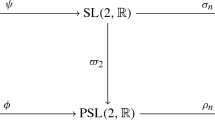Abstract
In 1991, Turaev and Viro constructed a quantum topological linear representation of mapping class groups of closed surfaces. To the mappings of a surface into itself, they assigned simple polyhedra whose boundaries consisted of two simple graphs cutting the surface into cells. The computational complexity of the Turaev-Viro representations strongly depends on the choice of suitable sets of simple polyhedra. In this paper, simple polyhedra for the torus are constructed. One of the reasons why they are convenient is that they all are obtained by gluing along boundary of copies of the same simple polyhedron.
Similar content being viewed by others
References
B. G. Casler, “An embedding theorem for connected 3-manifolds with boundary,”Proc. Amer. Math. Soc. 16, 559–566 (1965).
S. V. Matveev, “Special skeletons of piecewise linear manifolds,”Mat. Sb. [Math. USSR-Sb.],92, No. 2, 282–293 (1973).
S. V. Matveev, “Universal 3-deformations of special polyhedra,”Uspekhi Mat. Nauk [Russian Math. Surveys],42, No. 3, 193–194 (1987).
V. G. Turaev and O. Y. Viro, “State sum invariants of 3-manifolds and quantum 6j-symbols,”Topology,31, 865–902 (1992).
C. V. Matveev and A. T. Fomenko, “Isoenergetic surfaces of Hamiltonian systems, the enumeration of three-dimensional manifolds in order of growth of their complexity, and the calculation of the volumes of closed hyperbolic manifolds,”Uspekhi Mat. Nauk [Russian Math. Surveys],43, No. 1, 5–22 (1988).
R. Benedetti and C. Petronio,Branched Standard Spines of 3-Manifolds, Vol. 1653, Lecture Notes in Math, Springer, New York, (1997).
S. V. Matveev, “Zeeman conjecture for nonthickenable special polyhedra is equivalent to the Andrews-Curtis conjecture,”Sibirsk. Mat. Zh. [Siberian Math. J.],28, No. 6, 66–80 (1987).
S. V. Matveev, “Transformations of special spines and the Zeeman conjecture,”Izv. Akad. Nauk SSSR Ser. Mat. [Math. USSR-Izv.],51, No. 5, 1104–1116 (1987).
D. Gillman and D. Rolfsen, “The Zeeman Conjecture for standard spines is equivalent to the Poincaré Conjecture,”Topology,22, No. 3, 315–323 (1983).
S. V. Matveev, “Complexity theory of three-dimensional manifolds,”Acta Appl. Math.,19, 101–130 (1990).
S. V. Matveev,On a Computer Recognition of 3-Manifolds, MSRI Preprint No. 1997-028, MSRI (1997).
C. Adams, “SNAPPEA: The Week's hyperbolic 3-manifolds program,”Notices Amer. Math. Soc.,37, 273–275 (1990).
H. Zieschang, E. Vogt, and H.-D. Coldewey,Surfaces and Planar Discontinuous Groups, Springer-Verlag, Berlin-Heidelberg-New York (1980); H. Zieschang,Finite Groups of Mapping Classes of Surfaces, Springer-Verlag, Berlin-Heidelberg-New York (1981).
H. S. M. Coxeter and H. W. O. J. Moser,Generators and Relations for Discrete Groups, Springer-Verlag, Berlin-Heidelberg-New York (1957).
Author information
Authors and Affiliations
Additional information
Translated fromMatematicheskie Zametki, Vol. 66, No. 4, pp. 533–539, October, 1999.
Rights and permissions
About this article
Cite this article
Ovchinnikov, M.A. Representation of torus homeotopies by simple polyhedra with boundary. Math Notes 66, 436–441 (1999). https://doi.org/10.1007/BF02679093
Received:
Revised:
Issue Date:
DOI: https://doi.org/10.1007/BF02679093



